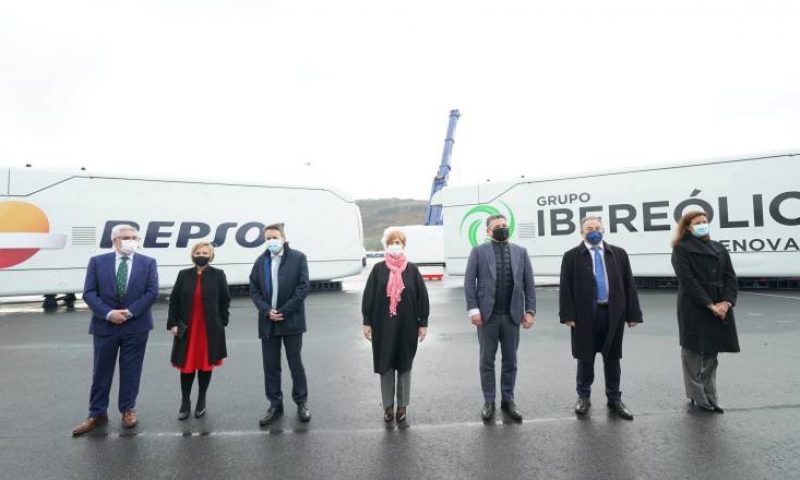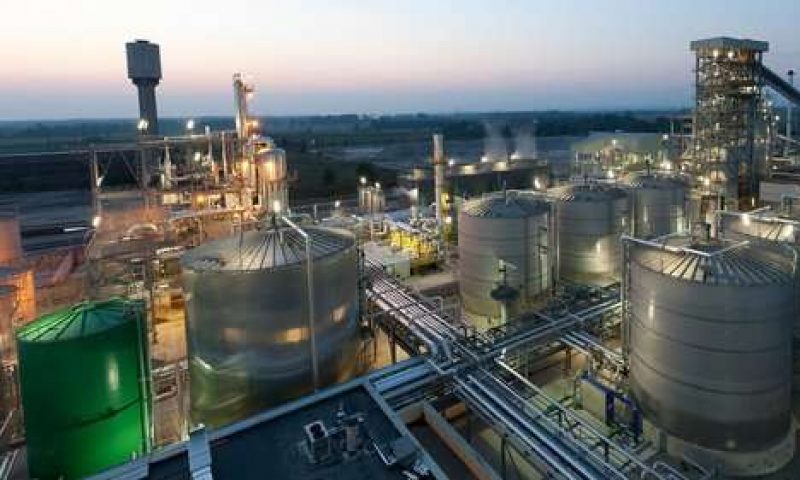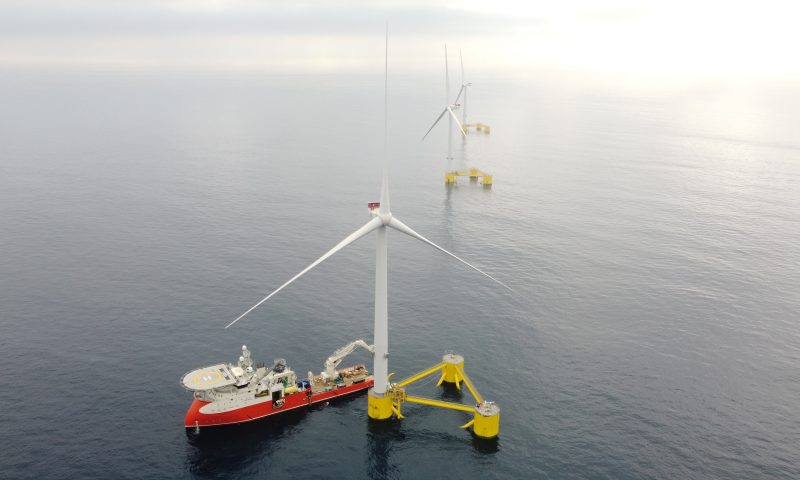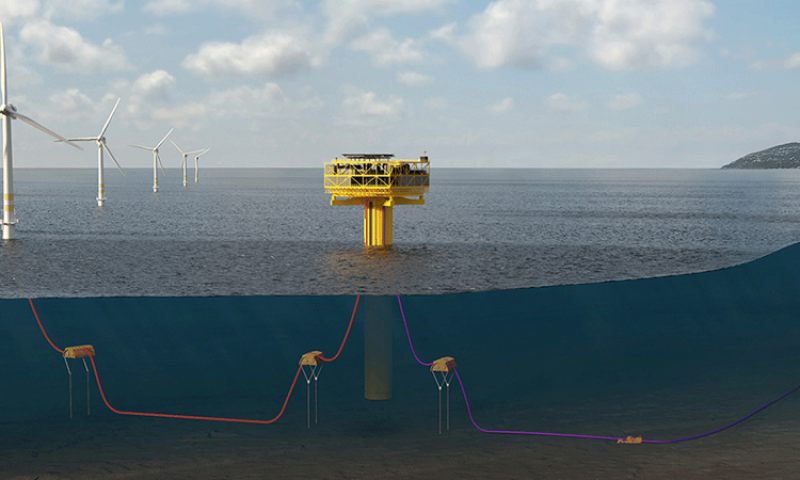
Repsol and Ibereólica Renovables Join Forces on Wind Farm in Chile
Repsol and Ibereólica Renovables advance in the construction of their first joint wind farm in Chile
Repsol and Grupo Ibereólica Renovables are moving forward in the construction of their first joint wind farm in Chile, called Cabo Leones III with 189 MW of installed capacity, with the shipment from the port of Bilbao of the main technological components for its wind turbines and the beginning of commercial operation of the first phase of this project in December last year.
Repsol CEO Josu Jon Imaz and the Chairman of Grupo Ibereólica Renovables, Gregorio Álvarez, today led a ceremony prior to the departure from Bilbao of the nacelles for the 22 SG 145, 5MW, wind turbines for the second phase of the Cabo Leones III wind farm, which will have an installed capacity of 110 MW. These are the most powerful and modern wind turbines that Siemens Gamesa currently have in operation.
The ceremony was presided over by the regional Minister for Economic Development and Infrastructures in the Basque Government, Arantxa Tapia, with the participation of the Chairman of Siemens Gamesa, Miguel Ángel López. Also attending were the Chairman of the Port Authority of Bilbao, Ricardo Barkala; the Managing Director of the Energy Agency of the Basque Government (EVE), Íñigo Ansola; the Representative for Economic Promotion of the Vizcaya Provincial Council, Ainara Basurko; and the Chairwoman of Repsol Electricidad y Gas, María Victoria Zingoni.
The Cabo Leones III wind farm is located in the Chilean province of Huasco, in the Atacama region. It will have a total renewable generation capacity of 189 MW, divided into two phases of 79 MW installed capacity and 110 MW, respectively.
This wind farm is part of the portfolio of projects in Chile of the joint venture between Repsol and Grupo Ibereólica Renovables that was created last July. The joint venture has a portfolio of assets in operation, construction, and advanced development of more than 1,600 MW, with commercial operation dates up until 2023, and the possibility of surpassing 2,600 MW by 2030.
The nacelles of this wind farm that are poised to depart from the port of Bilbao for Chile were assembled at the Siemens Gamesa plant in Ágreda (Soria) which employs close to 200 people.
Therefore, the economic activity of a wind project with these characteristics, although in Chile, is very important for Spain, both in the engineering phases and the production of the elements that make up the renewable facility, as well as their handling and transport. The complete journey from the plant in Ágreda to the Cabo Leones III wind farm, passing through the port of Bilbao, involves around 140 different companies.
The nacelle houses the multiplier, the generator, and other elements of the electrical system that are necessary to convert the wind power captured by the blades into electricity. All this is manufactured at the various Siemens Gamesa plants in Spain: the multipliers in Asteasu (Guipúzcoa), Mungia (Vizcaya), Lerma, Burgos, and Sigüeiro (A Coruña); and the electrical components at the plants in Reinosa (Cantabria), Madrid and Valencia. These factories have a total of more than 1,200 employees.
The first phase of the Cabo Leones III wind farm, with 79 MW and 22 SG 132 wind turbines, each with a capacity of 3.6 MW, already entered into commercial operation in December last year. It will produce 280 GWh of clean energy per year, thereby avoiding the annual emission of 94,000 tons of CO2 into the atmosphere.
The second phase of this project broke ground in July 2020. At peak times, the construction project is employing up to 150 workers. This facility is expected to enter into commercial operation in the second quarter of 2021.
“Committing to industry means committing to a rapid and stable economic recovery. With projects like this one, a wind farm in Chile that is also generating economic activity in our country, we are consolidating our position as an important player in the reduction of emissions and as a company that is contributing to the country’s industrial development,” said Repsol CEO Josu Jon Imaz.
“Repsol is advancing steadily towards achieving the low-carbon generation targets in its 2021-2025 Strategic Plan. The two milestones that bring us here today take us closer to our ambition of reaching 7,500 megawatts of low-emissions generation capacity by 2025, doubling this figure by 2030 and becoming a global operator. Furthermore, we are contributing to generating economic activity, in both Spain and Chile, which is so necessary right now,” said Josu Jon Imaz.
“With this first project in alliance with Repsol, our group, present in Chile since 2010, reaffirms its commitment to innovation as an essential catalyst for development in the renewable energy sector,” asserted Gregorio Álvarez, Chairman of Grupo Ibereólica Renovables.
“In the Grupo Ibereólica Renovables we have been working more than 24 years to develop, build, and operate renewable energy generation projects. With this innovative project that has brought us here today, we consolidate our position as one of the primary actors in the sector in Chile and globally,” added Gregorio Álvarez.
For his part, the Chairman of Siemens Gamesa, Miguel Ángel López, stated that:
“the Cabo Leones III Project is a clear example of our commitment, as well as the commitment of our partners Repsol and Ibereólica, to the economic and sustainable development and the protection of the environment in the places where we operate. This is our primary motivation. It is also another demonstration of the support we give to the activity of our providers that contribute significantly to the manufacture of the nacelles that are produced and assembled in the plants that we have in different regions.”
In addition to Cabo Leones III, the joint venture in Chile between Repsol and Grupo Ibereólica Renovables will also make it possible to develop, build, and commission by 2023 the Atacama and Antofagasta wind projects — with a total installed capacity of 180 and 794 MW, respectively—and the Elena solar project, with 540 MW.
On November 26 of last year, during the presentation of its 2021-2025 Strategic Plan, Repsol expanded and deepened its commitment to becoming a net zero emissions company by 2050, setting out a challenging roadmap involving more ambitious intermediate targets and investments totaling 18.3 billion euros over the coming years. The investments aimed at low-carbon initiatives will reach 5.5 billion euros between 2021 and 2025, 30% of the total.
Furthermore, Repsol reorganized its organizational structure by rolling out four new business areas, a cornerstone of the new model being Low-Emissions Generation. The company currently has nearly 3,000 MW of low-emissions generation capacity installed. It has six renewables projects under development in Spain — three wind (Delta, 335 MW; Delta 2, 860 MW; and PI, 175 MW) and three solar (Valdesolar, 264 MW; Kappa, 126 MW; and Sigma, 204 MW) — and it holds a stake in one of the world’s largest semi-submersible floating wind farms, Windfloat Atlantic, off the coast of Portugal, which is now in operation.
Grupo Ibereólica Renovables currently operates 12 wind farms with an installed capacity of 205 MW in Spain and 444 MW in Chile. Additionally, it has approximately 10 GW of wind and solar projects at different stages of development in Spain, Chile, Peru, and Brazil.













